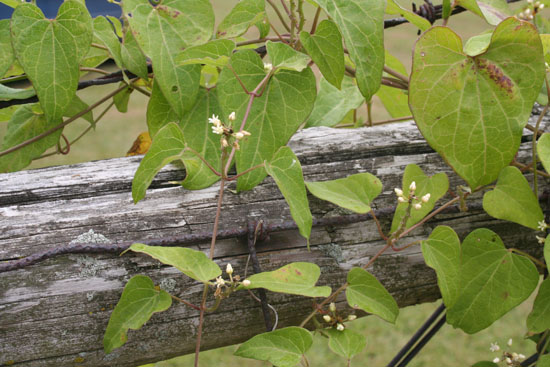Issue 11, July 2, 2009
Beware the Pretty Vines Found in the Landscape
Vining plants are often desirable in the home landscape. They cleverly disguise carefully placed trellises and their form seems to take on a life of its own. Some vines have been known to cover trees, poles, cars, and even slow moving animals I suspect. Quite a few vines are considered weedy by most. Too often, people will allow an unidentified, cute, little vine to flower. Fast forward a few years, and its population will be out of control. The initial cuteness impression will be long gone and efforts will be underway to eradicate it.
Proper identification is critical to good weed control as is scouting often for emerging weed issues. Need some help identifying those mystery vines? Here is a brief description of some of the more common weedy vines found in lawns and gardens. As with all broadleaf weeds, leaf arrangement, flower type and the presence of underground structures such as rhizomes or tubers all play a key role in identification.
Honeyvine milkweed (Ampelamus albidus) is a perennial vine that spreads by seed and long spreading roots. The leaves are heart-shaped on long petioles and opposite on the stem. Flowers are small, whitish, and borne in clusters. It forms a smooth, green seed pod that is similar to that of common milkweed. Pods persist into winter and can then be spotted easily in the landscape when evergreens are the backdrop. The presence of the pod is a dead giveaway for identifying this weed.

Hedge bindweed (Calystegia sepium) is a perennial vine that spreads by rhizomes. The leaves are alternate on the stem and are distinctly triangular in shape with a pointy tip. The leaf base is cut squarely. The flowers are white to pink, and funnel-shaped like that of morningglory, another vine I will discuss in a bit. Bindweed is often mistaken for morningglory which is an annual weed. Initially, it may not be perceived as much of a problem, although, the rhizomes can help this vine spread quickly.
Field bindweed (Convolvulus arvensis) is similar to hedge bindweed except the leaves are arrowhead shaped with a rounded tip. Also, the leaves are smaller and the leaf bases are rounded with outwardly divergent lobes. I try to keep the two straight by thinking "hedges have edges." Field bindweed is a rhizomatous perennial as well.

Wild buckwheat (Polygonum convolvulus) is similar also, but the lobes at the base of the leaf point backwards toward the petiole and it has an ochrea which is the easiest way to differentiate between these species. An ochrea is a papery sheath that encircles the stem where the petiole attaches to the stem. It is indicative of the smartweed family for which it is a member. Also, the flowers are greenish white and inconspicuous. They are clustered on long white racemes. Wild buckwheat is an annual so there are no rhizomes like the bindweeds have. Don't let this fool you; it is still considered a "serious weed" according to Weeds of the North Central States.
Morningglories (Ipomoea spp.) are often confused with bindweed and wild buckwheat too except the leaf shape is quite different. Depending on the species, leaves are either heart shaped or 3-lobed (ivy like). The cotyledons are butterfly-shaped. Most of the morningglories found in Illinois are summer annuals so reproduction is by seed. Bigroot morningglory or wild sweet potato as it's also called (I. pandurata) is a perennial found across the state. Both bigroot and tall morningglory have heart shaped leaves like honeyvine milkweed, however, the leaves are alternate on the stem. Bigroot morningglory can be distinguished by its reddish purple centered white flowers and large underground tubers.
Controls for vines include repeated pulling or cutting back, mowing, mulching, and herbicides. In a turf situation, grass should be properly maintained and mowed as high as possible. These vines have a difficult time growing in thick, lush turfgrass. Postemergent herbicides that provide at least some control of these vines include but are not limited to the following: 2,4-D, carfentrazone, quinclorac, dicamba, oxyfluorfen, and triclopyr. Glyphosate may also be used for spot applications as it is a non-selective herbicide. Be sure to carefully read and follow all label directions. Repeated applications may be necessary. Summer annual weeds are most susceptible to treatment in the spring or early summer when they are young. For perennials such as the bindweeds, fall applications may be most effective.

Beauty is in the eye of the beholder, you know. Just today as I snapped a picture of field bindweed in flower, an innocent bystander said that she thought the flowers were so pretty. She's right. They are pretty--up close. But when I see this vine cover a shrub, I can't think of it being anything other than a weed.--Michelle Wiesbrook
Author:
Michelle Wiesbrook